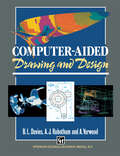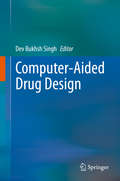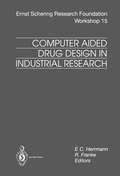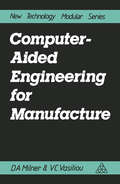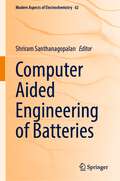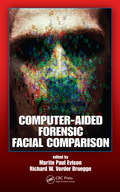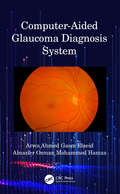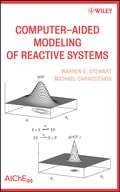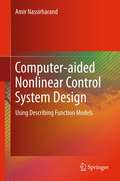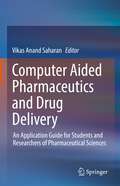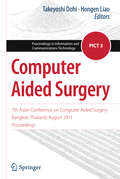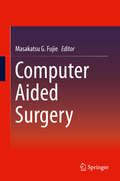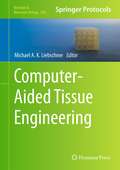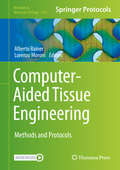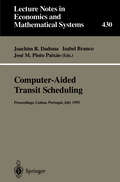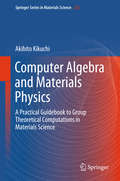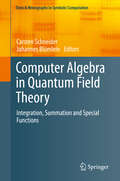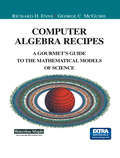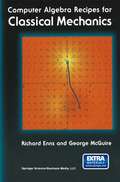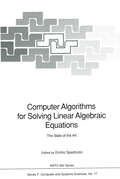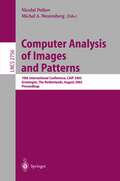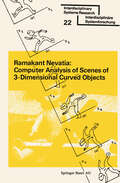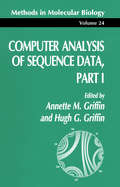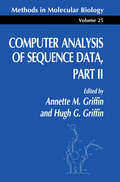- Table View
- List View
Computer-aided Drawing and Design
by DaviesThis book is intended for engineers, computer scientists, managers and all those concerned with computer graphics, computer-aided design and computer-aided manufacture. While it is primarily intended for students, lecturers and teachers, it will also appeal to those practising in industry. Its emphasis on applications will make it easier for those not currently concerned with computers to under stand the basic concepts of computer-aided graphics and design. In a previous text (Engineering Drawing and Computer Graphics), two of the authors introduced the basic principles of engineering drawing and showed how these were related to the fundamentals of computer graphics. In this new text, the authors attempt to give a basic understanding of the principles of computer graphics and to show how these affect the process of engineering drawing. This text therefore assumes that the reader already has a basic knowl edge of engineering drawing, and aims to help develop that understanding through the medium of computer graphics and by the use of a number of computer graphics exercises. The text starts by giving an overview of the basics of hardware and software for CAD and then shows how these principles are applied, in practice, in the use of a number of graphics packages of different levels of complexity. The use of a graphical database and the implications for computer-aided design and manufacture are also discussed. This book is unique in its applications approach to computer graphics.
Computer-Aided Drug Design
by Dev Bukhsh SinghThis book provides up-to-date information on bioinformatics tools for the discovery and development of new drug molecules. It discusses a range of computational applications, including three-dimensional modeling of protein structures, protein-ligand docking, and molecular dynamics simulation of protein-ligand complexes for identifying desirable drug candidates. It also explores computational approaches for identifying potential drug targets and for pharmacophore modeling. Moreover, it presents structure- and ligand-based drug design tools to optimize known drugs and guide the design of new molecules. The book also describes methods for identifying small-molecule binding pockets in proteins, and summarizes the databases used to explore the essential properties of drugs, drug-like small molecules and their targets. In addition, the book highlights various tools to predict the absorption, distribution, metabolism, excretion (ADME) and toxicity (T) of potential drug candidates. Lastly, it reviews in silico tools that can facilitate vaccine design and discusses their limitations.
Computer Aided Drug Design in Industrial Research (Ernst Schering Foundation Symposium Proceedings #15)
by R. Franke E. C. HerrmannThe Ernst Schering Research Foundation sponsored its 15th workshop in Berlin on October 19-21, 1994. Leading scientists from Europe and North America were invited to discuss computer-aided drug design in industrial research. Computer-aided drug design is a very exciting field and an intellec tual challenge, like playing chess. But these reasons are no longer suf ficient to justify using this method in industry, if they ever were. Fig. 1. The participants of the workshop VI Preface Therefore, when we, together with Prof. Hoyer, started to think about this workshop, our intentions quickly became clear. We were not so much interested in the very latest developments of methods or in computer-aided drug design itself - enough conferences have dealt with these topics. However, we were very interested in the usefulness and limitations of computer-aided drug design in the indu strial research process. A lot has changed in the pharmaceutical industry recently. These changes are gaining momentum, so it is the right time to think about the role of computer-aided drug design in this changing environment.
Computer-Aided Engineering for Manufacture
by Douglas A. MilnerThe development of the 'factory of the future' by major international corporations such as General Motors, IBM, Westinghouse, etc now involves many practising engineers. This book is an attempt to identify and describe some of the building blocks required for computer aided engineering for manufacture. It begins with numerical control and the infrastructure required for the automation of individual 'islands' within existing factories. Computer aided design and computer aided manufacture are then discussed in detail together with their integration to improve manufacturing efficiency and flexibility. Robotics and flexible manufacturing systems are examined, as well as the management of these systems required for production optimization. Finally, there is an overview of the relatively new field of artificial intelligence, which is being increasingly used in most aspects of computer aided engineering for manufacture. There are many topics which could have been included or expanded upon with advantage, but the authors have attempted to strike a balance so that the reader can obtain the maximum usefulness from a reasonably concise volume.
Computer Aided Engineering of Batteries (Modern Aspects of Electrochemistry #62)
by Shriram SanthanagopalanThis edited volume, with contributions from the Computer Aided Engineering for Batteries (CAEBAT) program, provides firsthand insights into nuances of implementing battery models in actual geometries. It discusses practical examples and gaps in our understanding, while reviewing in depth the theoretical background and algorithms. Over the last ten years, several world-class academics, automotive original equipment manufacturers (OEMs), battery cell manufacturers and software developers worked together under an effort initiated by the U.S. Department of Energy to develop mature, validated modeling tools to simulate design, performance, safety and life of automotive batteries. Until recently, battery modeling was a niche focus area with a relatively small number of experts. This book opens up the research topic for a broader audience from industry and academia alike. It is a valuable resource for anyone who works on battery engineering but has limited hands-on experience with coding.
Computer-Aided Forensic Facial Comparison
by Martin Paul Evison Richard W. Vorder BrueggeCountless facial images are generated everyday through digital and cell phone cameras, surveillance video systems, webcams, and traditional film and broadcast video. As a result, law enforcement and intelligence agencies have numerous opportunities to acquire and analyze images that depict persons of interest. Computer-Aided Forensic Facial Compari
Computer-Aided Glaucoma Diagnosis System
by Arwa Ahmed Gasm Elseid Alnazier Osman Mohammed HamzaGlaucoma is the second leading cause of blindness globally. Early detection and treatment can prevent its progression to avoid total blindness. This book discusses and reviews current approaches for detection and examines new approaches for diagnosing glaucoma using CAD system. Computer-Aided Glaucoma Diagnosis System, Chapter 1 provides a brief introduction of the disease and current methodology used to diagnose it today. Chapter 2 presents a review of the medical background of the disease, followed by a theoretical and mathematical background used in fundus image processing. Chapter 3 is a literature review about segmentation and feature extraction. Chapter 4 describes the formulation of the proposed methodology. In Chapter 5, the results of optic disc and optic cup segmentation algorithm are presented, the feature extraction and selection method, experimental results and performance evaluations of the classifier are given. Chapter 6 presents the conclusions and discussion of the future potential for the diagnostic system. This book is intended for biomedical engineers, computer science students, ophthalmologists and radiologists looking to develop a reliable automated computer-aided diagnosis system (CAD) for detecting glaucoma and improve diagnosis of the disease. Key Features Discusses a reliable automated computer-aided diagnosis system (CAD) for detecting glaucoma and presents an algorithm that detects optic disc and optic cup Assists ophthalmologists and researchers to test a new diagnostic method that reduces the effort and time of the doctors and cost to the patients Discusses techniques to reduce human error and minimize the miss detection rate and facilitate early diagnosis and treatment Presents algorithms to detect cup and disc color, shape features and RNFL texture features Dr. Arwa Ahmed Gasm Elseid is an assistant professor, Department of Biomedical Engineering, Sudan University of Science and Technology, Khartoum, Sudan. Dr. Alnazier Osman Mohammed Hamza is professor of Medical Imaging, College of Engineering, Sudan University of Sciences and Technology, Khartoum, Sudan.
Computer-Aided Glaucoma Diagnosis System
by Arwa Ahmed Gasm Elseid Alnazier Osman Mohammed HamzaGlaucoma is the second leading cause of blindness globally. Early detection and treatment can prevent its progression to avoid total blindness. This book discusses and reviews current approaches for detection and examines new approaches for diagnosing glaucoma using CAD system. Computer-Aided Glaucoma Diagnosis System, Chapter 1 provides a brief introduction of the disease and current methodology used to diagnose it today. Chapter 2 presents a review of the medical background of the disease, followed by a theoretical and mathematical background used in fundus image processing. Chapter 3 is a literature review about segmentation and feature extraction. Chapter 4 describes the formulation of the proposed methodology. In Chapter 5, the results of optic disc and optic cup segmentation algorithm are presented, the feature extraction and selection method, experimental results and performance evaluations of the classifier are given. Chapter 6 presents the conclusions and discussion of the future potential for the diagnostic system. This book is intended for biomedical engineers, computer science students, ophthalmologists and radiologists looking to develop a reliable automated computer-aided diagnosis system (CAD) for detecting glaucoma and improve diagnosis of the disease. Key Features Discusses a reliable automated computer-aided diagnosis system (CAD) for detecting glaucoma and presents an algorithm that detects optic disc and optic cup Assists ophthalmologists and researchers to test a new diagnostic method that reduces the effort and time of the doctors and cost to the patients Discusses techniques to reduce human error and minimize the miss detection rate and facilitate early diagnosis and treatment Presents algorithms to detect cup and disc color, shape features and RNFL texture features Dr. Arwa Ahmed Gasm Elseid is an assistant professor, Department of Biomedical Engineering, Sudan University of Science and Technology, Khartoum, Sudan. Dr. Alnazier Osman Mohammed Hamza is professor of Medical Imaging, College of Engineering, Sudan University of Sciences and Technology, Khartoum, Sudan.
Computer-Aided Modeling of Reactive Systems
by Warren E. Stewart Michael CaracotsiosLearn to apply modeling and parameter estimation tools and strategies to chemicalprocesses using your personal computer This book introduces readers to powerful parameter estimation and computational methods for modeling complex chemical reactions and reaction processes. It presents useful mathematical models, numerical methods for solving them, and statistical methods for testing and discriminating candidate models with experimental data. Topics covered include: Chemical reaction models Chemical reactor models Probability and statistics Bayesian estimation Process modeling with single-response data Process modeling with multi-response data Computer software (Athena Visual Studio) is available via a related Web site http://www.athenavisual.com enabling readers to carry out parameter estimation based on their data and to carry out process modeling using these parameters. As an aid to the reader, an appendix of example problems and solutions is provided. Computer-Aided Modeling of Reactive Systems is an ideal supplemental text for advanced undergraduates and graduate students in chemical engineering courses, while it also serves as a valuable resource for practitioners in industry who want to keep up to date on the most current tools and strategies available.
Computer-aided Nonlinear Control System Design: Using Describing Function Models
by Amir NassirharandA systematic computer-aided approach provides a versatile setting for the control engineer to overcome the complications of controller design for highly nonlinear systems. Computer-aided Nonlinear Control System Design provides such an approach based on the use of describing functions. The text deals with a large class of nonlinear systems without restrictions on the system order, the number of inputs and/or outputs or the number, type or arrangement of nonlinear terms. The strongly software-oriented methods detailed facilitate fulfillment of tight performance requirements and help the designer to think in purely nonlinear terms, avoiding the expedient of linearization which can impose substantial and unrealistic model limitations and drive up the cost of the final product.Design procedures are presented in a step-by-step algorithmic format each step being a functional unit with outputs that drive the other steps. This procedure may be easily implemented on a digital computer with example problems from mechatronic and aerospace design being used to demonstrate the techniques discussed. The author’s commercial MATLAB®-based environment, available separately from insert URL here, can be used to create simulations showing the results of using the computer-aided control system design ideas characterized in the text.Academic researchers and graduate students studying nonlinear control systems and control engineers dealing with nonlinear plant, particularly mechatronic or aerospace systems will find Computer-aided Nonlinear Control System Design to be of great practical assistance adding to their toolbox of techniques for dealing with system nonlinearities. A basic knowledge of calculus, nonlinear analysis and software engineering will enable the reader to get the best from this book.
Computer Aided Pharmaceutics and Drug Delivery: An Application Guide for Students and Researchers of Pharmaceutical Sciences
by Vikas Anand SaharanThis book examines the role of computer-assisted techniques for discovering, designing, optimizing and manufacturing new, effective, and safe pharmaceutical formulations and drug delivery systems. The book discusses computational approaches, statistical modeling and molecular modeling for the development and safe delivery of drugs in humans. The application of concepts of QbD (Quality by Design), DoE (Design of Experiments), artificial intelligence and in silico pharmacokinetic assessment/simulation have been made a lot easier with the help of commercial software and expert systems. This title provides in-depth knowledge of such useful software with illustrations from the latest researches. The book also fills in the gap between pharmaceutics and molecular modeling at micro, meso and maro scale by covering topics such as advancements in computer-aided Drug Design (CADD), drug-polymer interactions in drug delivery systems, molecular modeling of nanoparticles and pharmaceutics/bioinformatics. This book provides abundant applications of computers in formulation designing and characterization are provided as examples, case studies and illustrations. Short reviews of software, databases and expert systems have also been added to culminate the interest of readers for novel applications in formulation development and drug delivery. Computer-aided pharmaceutics and drug delivery is an authoritative reference source for all the latest scholarly update on emerging developments in computed assisted techniques for drug designing and development. The book is ideally designed for pharmacists, medical practitioners, students and researchers.
Computer Aided Surgery: 7th Asian Conference on Computer Aided Surgery, Bangkok, Thailand, August 2011, Proceedings (Proceedings in Information and Communications Technology #3)
by Takeyoshi Dohi Hongen LiaoThe aim of computer-aided surgery (CAS) is to advance the utilization of computers in the development of new technologies for medical services. The Asian Conference on Computer Aided Surgery (ACCAS) series provides a forum for academic researchers, clinical scientists, surgeons, and industrial partners to exchange new ideas, techniques, and the latest developments in the field. The ACCAS brings together researchers from all fields related to medical activity visualization, simulation and modeling, virtual reality for CAS, image-guided diagnosis and therapies, CAS for minimally invasive intervention, medical robotics and instrumentation, surgical navigation, clinical application of CAS, telemedicine and telesurgery, and CAS education. The ACCAS is also interested in promoting collaboration among people from different disciplines and different countries in Asia and the world. This volume helps to achieve that goal and is a valuable resource for researchers and clinicians in the field.
Computer Aided Surgery
by Masakatsu G. FujieThis book presents the latest research advances in the theory, design, control, and application of robot systems intended for a variety of purposes such as manipulation, manufacturing, automation, surgery, locomotion, and biomechanics. Several chapters deal with fundamental kinematics in nature, including synthesis, calibration, redundancy, force control, dexterity, inverse and forward kinematics, kinematic singularities, and over-constrained systems. This book is a compilation of the extended versions of the very best papers selected from the many that were presented at the Asian Conference on Computer-Aided Surgery held September 16–18, 2013, in Tokyo, Japan (ACCAS 2013).
Computer-Aided Tissue Engineering (Methods in Molecular Biology #868)
by Michael A. K. LiebschnerThe recent revolution in the biological sciences and bioengineering, along with the advancements of modern design and manufacturing, biomaterials, biology, and biomedicine, have brought about the new field of computer-aided tissue engineering. Advances in this fascinating new area of study encompass broad applications in large-scale tissue engineering fabrication, artificial organs, orthopaedic implants, and biological chips. Computer-Aided Tissue Engineering highlights the interdisciplinary nature of this topic and reviews the current state of computer-aided three-dimensional tissue modeling, tissue classification, and tissue fabrication and implantation. Particular focus is placed on rapid prototyping and direct digital fabrication for cell and organs, construction of tissue analogs, and precursors to 3D tissue scaffolds. Written for the highly successful Methods in Molecular Biology™ series, this work provides the kind of detailed description and implementation advice that is crucial for getting optimal results. Current and practical, Computer-Aided Tissue Engineering provides a coherent framework for researchers interested in these vital technologies and for clinicians who plan to implement them.
Computer-Aided Tissue Engineering: Methods and Protocols (Methods in Molecular Biology #2147)
by Alberto Rainer Lorenzo MoroniThis volume details protocols encompassing different aspects of computer aided design and manufacturing of 3D scaffolds and biofabricated constructs for tissue engineering applications. Chapters are divided into four parts covering optimization of scaffold architectures for computer aided tissue engineering, synthetic routes to biomaterials compatible, technological platforms and manufacturing processes, and relevant applicative scenarios. Written in the highly successful Methods in Molecular Biology series format, chapters include introductions to their respective topics, lists of the necessary materials and reagents, step-by-step, readily reproducible laboratory protocols, and tips on troubleshooting and avoiding known pitfalls. Authoritative and cutting-edge, Computer-Aided Tissue Engineering: Methods and Protocols aims to be useful for new and experienced laboratory researchers working on different aspects of corneal regeneration.
Computer-Aided Transit Scheduling: Proceedings of the Sixth International Workshop on Computer-Aided Scheduling of Public Transport (Lecture Notes in Economics and Mathematical Systems #430)
by Joachim R. Daduna Isabel Branco Jose M. P. PaixaoThis proceedings volume consists of papers presented at the Sixth International Workshop on Computer-Aided Scheduling of Public Transpon, which was held at the Fund~lio Calouste Gulbenkian in Lisbon from July 6th to 9th, 1993. In the tradition of alternating Workshops between North America and Europe - Chicago (1975), Leeds (1980), Montreal (1983), Hamburg (1987) and again Montreal (1990), the European city of Lisbon was selected as the venue for the Workshop in 1993. As in earlier Workshops, the central theme dealt with vehicle and duty scheduling problems and the employment of operations-research-based software systems for operational planning in public transport. However, as was initiated in Hamburg in 1987, the scope of this Workshop was broadened to include topics in related fields. This fundamental alteration was an inevitable consequence of the growing demand over the last decade for solutions to the complete planning process in public transport through integrated systems. Therefore, the program of this workshop included sections which dealt with scheduling problems and computerized systems for operational planning as well as sections on network planning and data management.
Computer Algebra and Materials Physics: A Practical Guidebook to Group Theoretical Computations in Materials Science (Springer Series in Materials Science #272)
by Akihito KikuchiThis book is intended as an introductory lecture in material physics, in which the modern computational group theory and the electronic structure calculation are in collaboration.The first part explains how to use computer algebra for applications in solid-state simulation, based on the GAP computer algebra package. Computer algebra enables us to easily obtain various group theoretical properties, such as the representations, character tables, and subgroups. Furthermore it offers a new perspective on material design, which could be executed in a mathematically rigorous and systematic way.The second part then analyzes the relation between the structural symmetry and the electronic structure in C60 (as an example of a system without periodicity). The principal object of the study was to illustrate the hierarchical change in the quantum-physical properties of the molecule, which correlates to the reduction in the symmetry (as it descends down in the ladder of subgroups).The book also presents the computation of the vibrational modes of the C60 by means of the computer algebra. In order to serve the common interests of researchers, the details of the computations (the required initial data and the small programs developed for the purpose) are explained in as much detail as possible.
Computer Algebra in Quantum Field Theory: Integration, Summation and Special Functions (Texts & Monographs in Symbolic Computation)
by Carsten Schneider and Johannes BlümleinThe book focuses on advanced computer algebra methods and special functions that have striking applications in the context of quantum field theory. It presents the state of the art and new methods for (infinite) multiple sums, multiple integrals, in particular Feynman integrals, difference and differential equations in the format of survey articles. The presented techniques emerge from interdisciplinary fields: mathematics, computer science and theoretical physics; the articles are written by mathematicians and physicists with the goal that both groups can learn from the other field, including most recent developments. Besides that, the collection of articles also serves as an up-to-date handbook of available algorithms/software that are commonly used or might be useful in the fields of mathematics, physics or other sciences.
Computer Algebra Recipes: A Gourmet’s Guide to the Mathematical Models of Science (Undergraduate Texts in Contemporary Physics)
by Richard Enns George C. McGuireComputer algebra systems allow students to work on mathematical models more efficiently than in the case of pencil and paper. The use of such systems also leads to fewer errors and enables students to work on complex and computationally intensive models. Aimed at undergraduates in their second or third year, this book is filled with examples from a wide variety of disciplines, including biology, economics, medicine, engineering, game theory, physics, and chemistry. The text includes a large number of Maple(R) recipes.
Computer Algebra Recipes for Classical Mechanics
by Richard H. Enns George C. McGuireThis is a standalone, but the recipes are correlated with topics found in standard texts, and make use of MAPLE (Release 7). As a reference text, or self-study guide this book is useful for science professionals and engineers.; Good for the classroom correlates with topics found in standard classical mechanics texts.; This book makes use of the powerful computer algebra system MAPLE (Release 7) but no prior knowledge of MAPLE is presumed.; The relevant command structures are explained on a need-to-know basis as the recipes are developed, thus making this a standalone text.
Computer Algorithms for Solving Linear Algebraic Equations: The State of the Art (NATO ASI Subseries F: #77)
by Emilio SpedicatoThe NATO Advanced Study Institute on "Computer algorithms for solving linear algebraic equations: the state of the art" was held September 9-21, 1990, at II Ciocco, Barga, Italy. It was attended by 68 students (among them many well known specialists in related fields!) from the following countries: Belgium, Brazil, Canada, Czechoslovakia, Denmark, France, Germany, Greece, Holland, Hungary, Italy, Portugal, Spain, Turkey, UK, USA, USSR, Yugoslavia. Solving linear equations is a fundamental task in most of computational mathematics. Linear systems which are now encountered in practice may be of very large dimension and their solution can still be a challenge in terms of the requirements of accuracy or reasonable computational time. With the advent of supercomputers with vector and parallel features, algorithms which were previously formulated in a framework of sequential operations often need a completely new formulation, and algorithms that were not recommended in a sequential framework may become the best choice. The aim of the ASI was to present the state of the art in this field. While not all important aspects could be covered (for instance there is no presentation of methods using interval arithmetic or symbolic computation), we believe that most important topics were considered, many of them by leading specialists who have contributed substantially to the developments in these fields.
Computer Analysis of Images and Patterns: 10th International Conference, CAIP 2003, Groningen, The Netherlands, August 25-27, 2003, Proceedings (Lecture Notes in Computer Science #2756)
by Nicolai Petkov Michel A. WestenbergThis volume presents the proceedings of the 10th International Conference on Computer Analysis of Images and Patterns (CAIP 2003). This conference - ries started about 18 years ago in Berlin. Initially, the conference served as a forum for meetings between scientists from Western- and Eastern-bloc co- tries. Nowadays, the conference attracts participants from all over the world. The conference gives equal weight to posters and oral presentations, and the selected presentation mode is based on the most appropriate communication medium. The programme follows a single-track format, rather than parallel s- sions. Non-overlapping oral and poster sessions ensure that all attendees have the opportunity to interact personally with presenters. As for the numbers, we received a total of 160 submissions. All papers were reviewed by two to three members of the Programme Committee. The ?nal - lection was carried out by the Conference Chairs. Out of the 160 papers, 42 were selected for oral presentation and 52 as posters. At this point, we wish to thank the Programme Committee and additional referees for their timely and high-quality reviews. The paper submission and review procedure was carried out electronically. We thank Marcin Morg´ os from Scalar–IT Solutions for p- viding us with the Web-based participant registration system. We also thank the invited speakers Nicholas Ayache, John Daugman, and Dariu Gavrila, for kindly accepting our invitation.
Computer Analysis of Scenes of 3-Dimensional Curved Objects (Interdisciplinary Systems Research)
by NEVATIA1.0 2 The attention then turned to the problem of "Body separation", i.e. separation of occluding bodies in a scene (See [Guzman), [Falk), and [Waltz)). Grape ([Grape)) combined the separation of bodies with recognition, by removing parts of the scene recognized as belonging to a known body. All of these techniques were designed to work with polyhedral objects only, and extensively use the properties of edges and vertices. Though some impressive results have been reported ([Waltz], [Grape)), and perhaps some useful abstractions can be made, the specific techniques used fail to generalize to a wider class of objects. Among previous work on curved objects, B.K.P. Horn ([Horn)) presented techniques for extracting three dimensional depth data from a TV image, using reflection characteristics of the surface. Krakauer ([Krakauer]) represented objects by connections of brightness contours. Ambler et al ([Ambler)) describe experiments with simple shapes, including curved objects, using relations within a two-dimensional image. However, none of these efforts really addresses the problem of "shape" representation and description. Work on outdoor scene analysis is also concerned with non-polyhedral objects ([Bajcsy], [Yakimovsky]), but again no attention has been paid to shape analysis.
Computer Analysis of Sequence Data, Part I (Methods in Molecular Biology #24)
by Annette M. Griffin Hugh G. GriffinDNA sequencing has become increasingly efficient over the years, resulting in an enormous increase in the amount of data gen- ated. In recent years, the focus of sequencing has shifted, from being the endpoint of a project, to being a starting point. This is especially true for such major initiatives as the human genome project, where vast tracts of DNA of unknown function are sequenced. This sheer volume of available data makes advanced computer methods ess- tial to analysis, and a familiarity with computers and sequence ana- sis software a vital requirement for the researcher involved with DNA sequencing. Even for nonsequencers, a familiarity with sequence analysis software can be important. For instance, gene sequences already present in the databases can be extremely useful in the design of cloning and genetic manipulation experiments. This two-part work on Analysis of Data is designed to be a practical aid to the researcher who uses computers for the acquisition, storage, or analysis of nucleic acid (and/or p- tein) sequences. Each chapter is written such that a competent sci- tist with basic computer literacy can carry out the procedure successfully at the first attempt by simply following the detailed pr- tical instructions that have been described by the author. A Notes section, which is included at the end of each chapter, provides advice on overcoming the common problems and pitfalls sometimes enco- tered by users of the sequence analysis software. Software packages for both the mainframe and personal computers are described.
Computer Analysis of Sequence Data Part II (Methods in Molecular Biology #25)
by Annette M. Griffin Hugh G. GriffinDNA sequencing has become increasingly efficient over the years, resulting in an enormous increase in the amount of data gener ated. In recent years, the focus of sequencing has shifted, from being the endpoint of a project, to being a starting point. This is especially true for such major initiatives as the human genome project, where vast tracts of DNA of unknown function are sequenced. This sheer volume of available data makes advanced computer methods essen tial to analysis, and a familiarity with computers and sequence analy sis software a vital requirement for the researcher involved with DNA sequencing. Even for nonsequencers, a familiarity with sequence analysis software can be important. For instance, gene sequences already present in the databases can be extremely useful in the design of cloning and genetic manipulation experiments. This two-part work on Computer Analysis of Sequence Data is designed to be a practical aid to the researcher who uses computers for the acquisition, storage, or analysis of nucleic acid (and/or pro tein) sequences. Each chapter is written such that a competent scien tist with basic computer literacy can carry out the procedure successfully at the first attempt by simply following the detailed prac tical instructions that have been described by the author. A Notes section, which is included at the end of each chapter, provides advice on overcoming the common problems and pitfalls sometimes encoun tered by users of the sequence analysis software.
